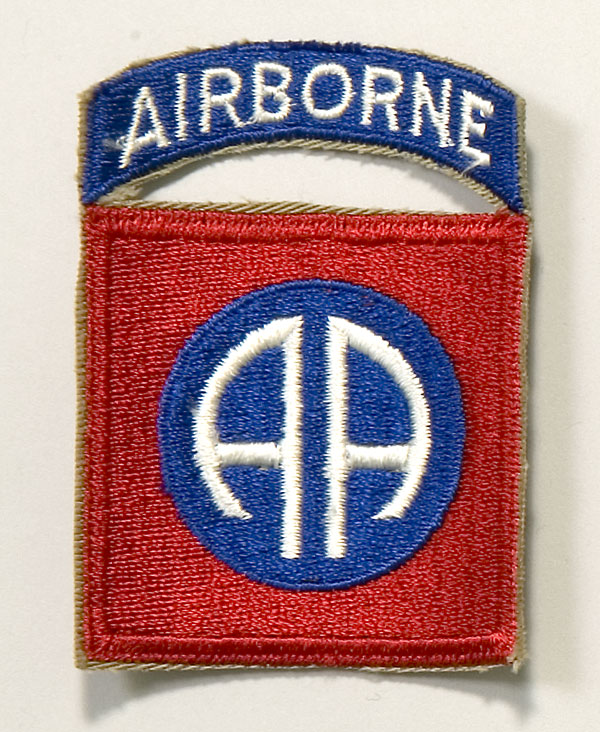Military Patch
c 1942-1945
US Army Cloth Shoulder Patch for the 82nd Airborne Division, nicknamed "All-American." Worn August 31, 1942 to present. Unissued.
The 82nd Division had been a regular infantry unit in World War I. In WWII, the word “Airborne” was added to their insignia. The double “AA” stood for the fact that it contained soldiers from all forty-eight states, making it “The All American Division.”
On D-Day the 82nd Airborne Division’s drop zones were near the village of St. Mere-Eglise on the Cotentin Peninsula. Because some 82nd men unintentionally parachuted right on top of a German force occupying the town, casualties were high. More of the division arrived and pressed the attack. After desperate fighting, St. Mere-Eglise became the first substantial French town liberated by the Allies.
Holding this crossroads helped the Americans block German attempts at sending tanks and other reinforcements against the beachhead being established by the 4th Infantry Division. It is possible that without the airborne support dropped inland on D-Day, the invasion might have failed.
It was over the objections of Air Chief Marshal Leigh-Mallory, who thought that the casualties would be extremely high, that both General Eisenhower and his British Deputy Commander, Air Chief Marshal Tedder, insisted the airborne operations were necessary. The results proved Ike and Sir Arthur Tedder to be correct.
The 82nd Division, under Major General Matthew Ridgeway, fought in the Nijmegan, Grave, and Groesbeek area of the Netherlands during Operation MARKET-GARDEN. On September 20, 1944, the 3rd Battalion of the division’s 504th Parachute Regiment, led by Major Julian Cook, made a daring amphibious attack across the 400 yard-wide Waal River in canvas assault boats. Their objective was the capture of two heavily defended bridges. The enemy defending the bridges had several cannons and at least 34 machine guns.
Incredibly, despite stiff resistance, the men successfully seized the Nijmegan Railroad Bridge from the far end. Major Cook and his soldiers then assisted a tank unit from the British XXX Corps in the taking the nearby Nijmegan Highway Bridge. Approximately 200 Americans and over 267 Germans were killed in this battle. Julian Cook, a 1940 graduate of West Point, received the Distinguished Service Cross for leading this assault.
Major General James Gavin was the division commander when the unit participated in the Battle of the Bulge in the winter of 1944-1945. The 82nd fought in the St. Vith region where, after hard fighting, it drove the German advance back across the Ambleve River. By the end of the war the All Americans had suffered 8,511 in killed and wounded. Prior to D-Day it had already seen combat in Sicily and Italy.
Cloth. H 8.9, W 6.4 cm
Eisenhower National Historic Site, EISE 9553.



